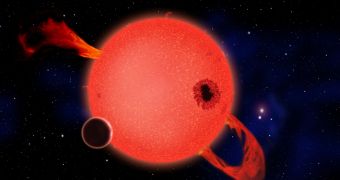Astronomers have been looking for planets and life all over the galaxy, but maybe they need to look closer to home. A new study by astronomers at the Harvard-Smithsonian Center for Astrophysics indicates that a big number of red dwarfs in the galaxy have Earth-sized planets in the habitable zone.
Red dwarfs are the most numerous stars in the Milky Way and, as luck would have it, most of our closest neighbors are red dwarfs.
Based on Kepler data, astronomers predict that six percent of red dwarfs have small rocky planets in their habitable zone. Red dwarfs, as their name suggests, are smaller and cooler than the sun.
They can be a third the size and 1,000 times dimmer, meaning that planets have to be much closer than Earth is to the sun for them to get enough energy to keep water in its liquid form.
Incidentally, most of the rocky planets found by Kepler circle much closer to their stars than any of the planets in our solar system. That may be a result of Kepler's capabilities and methods, but what is clear is that star systems with planets close to their stars are abundant.
Based on the research, astronomers believe that the closest Earth-like exoplanet may be just 13 light-years away. That's based on probability alone, there is no candidate so close.
The researchers looked at 95 planet candidates (planets which haven't been confirmed yet) found by the Kepler Space Telescope orbiting 64 red dwarfs.
Most of those are too far away, too close to harbor life similar to the one on Earth or they're too big. Three of them though are just the right size at the right distance. Extrapolating from this, astronomers predict that six percent of red dwarfs have planets around them in the habitable zone.
75 percent of the stars around us are red dwarfs, too dim to see with the naked eye. In the galaxy, there are an estimated 75 billion red dwarfs, perhaps more. That's 4.5 billion Earth-sized planets orbiting in the habitable zone of their stars.
Before you get your hopes up, there are a few caveats. The habitable zone, which incidentally has been currently redefined, as is now proposed only looks at whether the distance to the star would allow for liquid water.
But there are plenty of other factors involved, the presence of an atmosphere, a liquid core to maintain a magnetic field to deflect cosmic radiation and so on and so forth.
As for red dwarfs, planets would have to be so close to be in the habitable zone that they would be much more affected by things like solar flares, not to mention the star's huge gravity. Of course, there's also the obvious caveat that 64 stars out of 75 billion can hardly be considered a representative sample.

 14 DAY TRIAL //
14 DAY TRIAL //